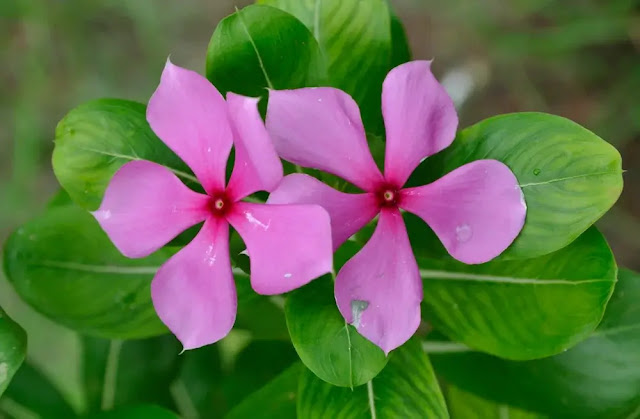Periwinkle has traditionally been used as a folk remedy for diabetes in South Africa while in traditional Chinese medicine the extracts of the plant have been used against malaria.
Periwinkle: An Invaluable Medicinal Plant
-Dr. Arvind Singh
Periwinkle is a common ornamental plant grown in the gardens of residential and official compounds. It is scientifically known as Catharanthus roseus synonym Vinca rosea and belongs to the Apocynaceae family of flowering plants. Periwinkle is native of South-eastern and eastern Madagascar found growing as wild plant species in the rain forest.
Read: Salkhan Fossil Park
European colonists exported periwinkle widely as an ornamental plant. It is now grown almost worldwide and is found naturalized in most tropical and subtropical regions following escapes from cultivation. The other common name of the plant includes Madagascar periwinkle, Rosy periwinkle, Cape periwinkle, Rose periwinkle and “Old-maid”.
In India periwinkle is known with different names. In Hindi, it is known as Sadabahaar, in Bengali as Nayantara, in Marathi as Sadaphuli, in Malayalam as Shavam Naari and in Tamil as Nityhakalyani.
Characteristics of Periwinkle:
Periwinkle is an evergreen perennial herb attaining height up to 80 cm. The plant has glossy, dark green, oval leaves. Flowers usually 2-3 in cymose clusters. The flowers are white, pink or rosy-purple in colour and are adapted to pollination by insects. Fruits are of follicle type and are many-seeded.
The plant is either raised through root cuttings or by seeds. Periwinkle is generally avoided by the grazing animals.
Periwinkle Medicinal attributes:
Periwinkle is a plant of immense medicinal value. All part of the plant is medicinally important, however, alkaloids are mostly concentrated in the root bark. These include three important alkaloids of Rauvolfia group i.e. ajmalicine, reserpine and serpentine. In addition to these, the other important alkaloids found are vindoline, vincristine and vinblastin.
Periwinkle Medicinal uses:
The plant has traditionally been used as a folk remedy for diabetes in South Africa while in traditional Chinese medicine the extracts of the plant have been used against malaria.
The juice of the leaves is used as an antidote against wasp stings. The root is considered tonic and stomachic. The infusion of the leaves is given in the treatment of menorrhagia.
The alkaloids like ajmalicine, serpentine and reserpine have hypotensive, sedative and tranquillizing properties. Therefore, the plant is used in the treatment of hypertension and mental disorders like depression and insanity.
Read: Social forestry in India
Herbal remedies made with periwinkle help in toothache, memory loss and blood circulation.
The alkaloids also inhibit the growth of Vibrio cholerae (Cholera causing bacterium). The vindoline alkaloid from leaves is active against Diphtheria causing bacterium Corynebacterium diptheriae. The leaf extracts of periwinkle serve as a useful anti-bacterial agent for the treatment of Staphylococcal and Streptococcal infections. These two types of infections often lead to rheumatic heart troubles in human beings.
The plant possesses anti-cancer property as well. The alkaloids vincristine and vinblastin obtained from the plant is useful in the treatment of Leukaemia and Hodgkin’s lymphoma.
Periwinkle can be dangerous if consumed orally. The plant should be avoided by pregnant women.
Conclusion:
Conclusively it can be said that periwinkle commonly grown as an ornamental plant in urban areas is a plant of immense medicinal importance. The plant possess several alkaloids which are useful in the treatment of hypertension, insomnia, insanity, cholera and blood cancer (Leukaemia).
Author Bio:
 Dr. Arvind Singh is M. Sc. and Ph. D. in Botany with an area of specialization in Ecology. He is a dedicated Researcher having more than four dozens of published research papers in the journals of national and international repute. His main area of research is the Restoration of Mined Lands. However, he has also conducted research on the Vascular Flora of Banaras Hindu University-Main Campus, Varanasi (India). Furthermore, he is also an active science writer having more than 10 dozens of published science articles in different periodicals of national repute. His email address is: arvindsingh_bhu@hotmail.com
Dr. Arvind Singh is M. Sc. and Ph. D. in Botany with an area of specialization in Ecology. He is a dedicated Researcher having more than four dozens of published research papers in the journals of national and international repute. His main area of research is the Restoration of Mined Lands. However, he has also conducted research on the Vascular Flora of Banaras Hindu University-Main Campus, Varanasi (India). Furthermore, he is also an active science writer having more than 10 dozens of published science articles in different periodicals of national repute. His email address is: arvindsingh_bhu@hotmail.com
keywords: periwinkle medicinal uses, periwinkle flower information, periwinkle plant information, periwinkle flower for diabetes, periwinkle flower benefits, periwinkle flower meaning, vinca minor medicinal uses, vinca rosea medicinal uses, catharanthus roseus medicinal use, periwinkle herb informtion, periwinkle plant ayurvedic use, catharanthus roseus medicinal uses, catharanthus roseus plant, catharanthus roseus diabetes, catharanthus roseus toxicity, vinca rosea medicinal uses, vinca rosea flower, vinca rosea in diabetes, vinca rosea cultivation, periwinkle benefits, how to make periwinkle tea, health benefits of periwinkle snail, periwinkle flower for diabetes, health benefits of periwinkle seafood, periwinkle plant poisonous, periwinkle plant facts, rosy periwinkle medicinal uses, periwinkle plant scientific name

